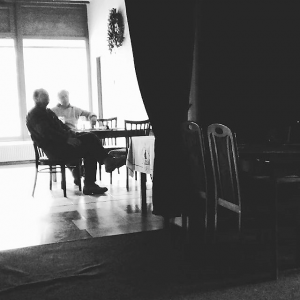Anna Luňáková
“introduction to the studies of melancholy“
…simple things are beautiful, but they are not easy to create.
Every day I face feelings of loneliness, uprooting, a fundamental lack. I used to be absorbed in this melancholy state and considered it romantic. This unbalanced almost hysterical feeling of “youth” began to be replaced over the years by somewhat more harmonious, state of concentrated calm, but melancholy, in its natural immortality, never quite left me. On the contrary, she enchanted me perfectly.
With this post I would like to share my observation of melancholy.

I.
Whether I was a waitress, a cleaning lady, a bartender in a club, but also a security guard at a zoo or a hostess of tastings in shopping malls, whether I watched the workers in the glassworks where my mother worked or it was my many years lasting work with horses… I got a chance to meet people who get up for work between four and half past five in the morning. These people have a special character for me. This character, as with a blotting paper, is transcribed into their posture, facial expression, gestures, and the atmosphere that surrounds them. Whether it was during my morning departure or late return from work, on the lines of suburban buses, and therefore on the periphery of Prague connections, I always observed almost sculptural scenes of bodies, especially of male workers. And these living statues fascinated me.
Of all the “homeless people” in this world, I am most attracted to the “old man”, who by all standards has no place, no use, no consolation in this world, unless he becomes a heroic figure of a wise preacher. The word old does not mean age here. It’s a situation. An old man can also be a young woman. An old, thoughtful boy can have an old man inside him. For me, the old man is a visual archetype of melancholy.
How to turn all this into a scene? How to stage the body? And how to present the fascination to the viewer so that he gets a chance to be interested in the old man? How to let the old man speak in us?
II.
… And how to describe this “homelessness of melancholy”?
Like the homelessness of a man who does not feel at home in this world, but has been denied access to the gods; the homelessness of an artist who is obsessed with doubt, an eternally unfinished, until then perfect work; homelessness of genius without material conditions for creation; and finally the homelessness of the thinker, free only where neither ethics nor morality prevail.
Homelessness is experienced by a child who feels like a bird in a bad nest, homelessness is also the everyday life of an anarchist who refuses to submit to social dictation, homelessness is not wanting a family, a house and a big car; but homelessness is often to have a family, a house and a big car, homelessness is a person in a public space who has been expropriated by a foreign ideology. Homelessness is a fragile hour between four and five in the afternoon, when the edges of things are lost and the world melts into a fog of uncertainty.
An old man, a homeless man, a melancholic appears everywhere. First as a significant character; whether it is a teacher-philosopher or a grandfather, this unexplored, mysterious, touchingly boring character, but sometimes also an evil, cynical, convicted and alcoholic person. He is also the character of a pensioner, eternally commenting, eternally invisible… Finally, I also discovered my own “old man”.
III.
what would a melancholic say to the silence after a storm
“When one tries to pull oneself by the hair from the swamp, one’s words keep the other, unspoken world alive. There was a fundamental derailment. This derailment is not outside of me, but I decide on it, as well as on everything else that I do not have in control. I don’t believe in the outside. I’m a swing with a compulsive balance disorder. I’m sick. I’m crossing borders while just drawing them. When the world falls apart, there is inner confusion – this is the situation of a person off the map. As can be seen, human life is doomed to failure. However, this failure is not a matter for the future, but it is always present. The specific homelessness associated with it says: There is no way to end me. There is no moment, a comparison, a point at which one has gone in the wrong direction. Even death does not stop homelessness, so I do not comply in all respects. Surely you understand where I am going – madness as a reward for everything overcoming the feeling of absence, an effort to mythologize your life. But it, as a myth, can neither be revealed nor named, but only and infinitely developed. Fortunately, madness also has brothers and sisters. They are philosophy, poetry or even divination.
No, thanks, healing would probably kill us… witnesses of origin, witnesses of the constant transition between being and non-being do not stand in the present, but outside time alone, because everything is clear to them, everything is seen, everything is heard and everything is at once.
Danger comes from ordinary life, rejecting ecstasy, not death!
We can’t forget. Loneliness that cannot be ended by death. Loneliness… This closed world, which conceives everything in such a way that it can successfully disguise even the lack… This world, the love…
That terrible ubiquitous love. “
IV.
Characteristic traits of the figure:
-
Awareness of the inadequacy of concepts, the fact that the word will always be weaker than the presence of things, unless spoken by someone so present as to transcend the thing. Emphasis on material.
-
His body corresponds to the soul and soul to the body; there is a fundamental similarity; duality.
- He corresponds to the state of the cosmos, again a resemblance, this time to man and the world, one could even say the “environment” in which the homeless-melancholic lives and must live.
-
W = F.s; thus, work is the action of a force on a material object, it is mechanical work performed at a material point performing a sliding motion. In contrast, the dancer moves himself on the path through the cosmos, which is his working environment. This is the definition of a homeless person who is seemingly “out of work”, he is his job.
-
A homeless man is one who breaks the law. He does not get into this situation voluntarily, and yet by his will. This paradox is a perfect description of his life. The relationship he has formed to his destiny decides on him as much as the cosmos (environment, destiny), over which he has no control. This is directly expressible in motion – limits and centre.
-
After establishing a relationship with oneself, with the cosmos, etc., the last phase: engagement, addressing, appeal, and fall; the figure of the homeless-melancholic is also the figure of the seer: because he is out of order, he can talk about him.
And what does this homeless person see?
WE HAVE THE FUTURE INSIDE US AND IT IS NOT OUTSIDE OF US
Anna Luňáková (*1993)
 Studied philosophy at the Faculty of Arts at Charles University in Prague, and currently is a PhD. student engaged in romance literature. So far, she has published two books, the novel Three (2020) and the collection of poems I just lose my name (2020). She also translates from French (Letter to D., 2021) and Portuguese. She creates authorial performances, i.e. Bohemia, performed in 2018 in Paris, Elevation 2018 in Casablanca, Přeslice 2019 in Setúbal or Odposlech 2020 in Malovice. The last mentioned, Odposlech, was created under the newly emerging collective HERONS VECTOR, of which she is a co-founder, together with Jakub Štourač and Ondřej Macl. She is also the co-founder of the open platform Nothing is a problem here, which organizes authorial readings, events and cabaret.
Studied philosophy at the Faculty of Arts at Charles University in Prague, and currently is a PhD. student engaged in romance literature. So far, she has published two books, the novel Three (2020) and the collection of poems I just lose my name (2020). She also translates from French (Letter to D., 2021) and Portuguese. She creates authorial performances, i.e. Bohemia, performed in 2018 in Paris, Elevation 2018 in Casablanca, Přeslice 2019 in Setúbal or Odposlech 2020 in Malovice. The last mentioned, Odposlech, was created under the newly emerging collective HERONS VECTOR, of which she is a co-founder, together with Jakub Štourač and Ondřej Macl. She is also the co-founder of the open platform Nothing is a problem here, which organizes authorial readings, events and cabaret.